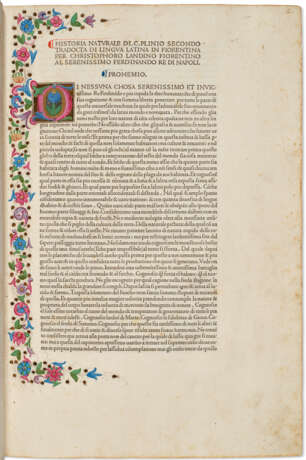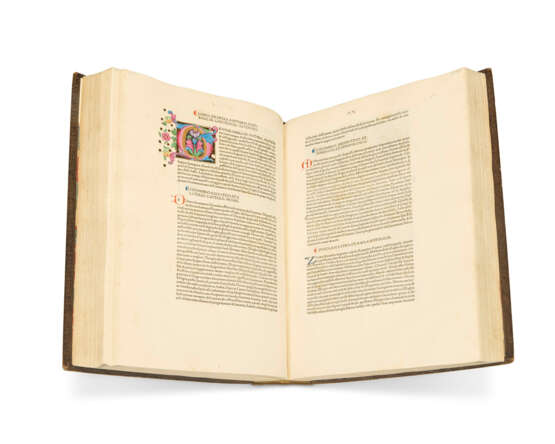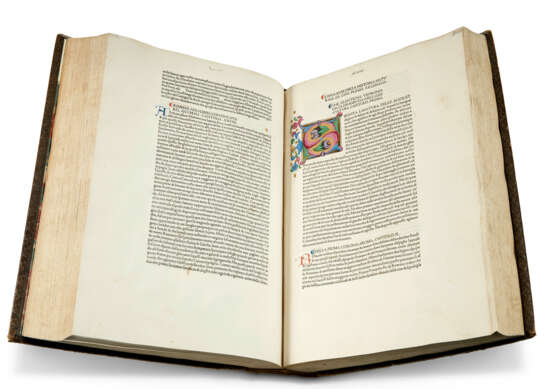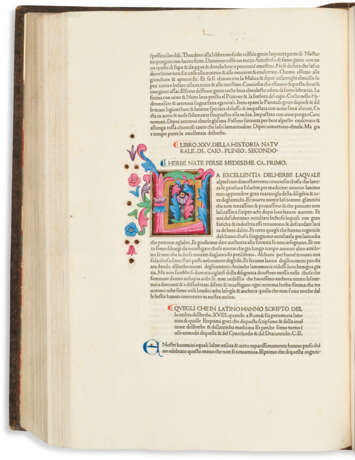ID 1360764
Lot 48 | Historia naturalis, in Italian
Estimate value
$ 100 000 – 150 000
First edition in Italian, richly illuminated. Variously called the fount of all ancient knowledge, Pliny’s Historia naturalis was the first important scientific text to appear in print. ‘The Natural History of Pliny the Elder is more than a natural history; it is an encyclopaedia of all the knowledge of the ancient world […] When he died the Natural History (the sole extant work out of one hundred and two volumes from his pen) was still incomplete. It comprises thirty-seven books dealing with mathematics and physics, geography and astronomy, medicine and zoology, anthropology and physiology, philosophy and history, agriculture and mineralogy, the arts and letters. […] The Historia soon became a standard book of reference: abstracts and abridgements appeared by the third century, Bede owned a copy, Alcuin sent the early books to Charlemagne, and Dicuil, the Irish geographer, quotes him in the ninth century […] Over and over again it will be found that the source of some ancient piece of knowledge is Pliny’ (PMM 5).
The present copy was likely illustrated in northern Italy, and displays a grand Roverella style, so named for the 1474 Venetian edition of Gratianus’ Decretum by Jenson which displays the Roverella coat of arms and whose extensive illuminations are characterised by prominent pink initials on gold rectangles and sweeping floral embellishments (private communication by Lilian Armstrong to the owner).
All of the 18 recorded incunable editions were printed in Italy, and this edition is the most well-documented production of Jenson’s renowned press. The translation by Christophorus Landinus and the paper (86 bales of it) were both commissioned by the Strozzi, the powerful Florentine banking family, in conjunction with Giovambattista Ridolfi. Ridolfi and Girolamo Strozzi remained in Venice during the printing of the edition, and Ridolfi took delivery of copies by September of that year. Approximately 200 copies were printed on vellum and 1000 on paper, with two noted illuminated vellum copies now held at Holkham Hall and the Bodleian Library (de Roover).
The 1476 Pliny is a masterpiece of typographic design, printed with Jenson’s influential Roman types and in proportions that continue to be emulated today. ‘Jenson’s Roman types have been the accepted models for roman letters ever since he made them, and, repeatedly copied in our own day’ (Updike, Printing Types, I.73).
Giordana Mariani Canova, Ferrara 1474: miniatura, tipografia, committenza (Centro Di, 1988. F. de Roover, ‘Per la storia dell’arte della stampa in Italia’, La bibliofilía 55 (1953), 107–17. D.B. Updike, Printing Types (Harvard University Press, 1922). H *13105; BMC V 176; BSB-Ink P-611; Bod-inc P-372; CIBN P-469; GW M34342; Goff P-801; Klebs 787.1; ISTC ip00801000.
Royal folio (405 × 275mm). 413 leaves (of 415, without first and final blanks). Contemporary north Italian illumination; 11-line initials for each book illuminated in pink and mauve with blue and green acanthus extensions and white penwork, decorated with flowers and with short borders of flowers, leaves and gold disks; full-length border on the prologue leaf, rubricated with 2-line initials alternating in red and blue over printed guide-letters, paragraph marks in alternating red and blue, chapters numbered in the headers in brown ink; modern pencil foliation (1/6 cropped to text and inlaid with the illuminated border drawn to match that on 1/2 presumably at the time of binding, occasional repaired marginal tears rarely affecting text, very mild spotting/toning, occasional stains mainly in final leaves). 19th-century blindstamped morocco, spine with raised bands and gilt-lettered (overall light rubbing, few nicks to lower cover, joints and extremities a little abraded). Provenance: early marginalia (occassionally trimmed).
| Place of origin: | Italy |
|---|---|
| Auction house category: | Antiquarian books, Medicine & science, Printed books |
| Place of origin: | Italy |
|---|---|
| Auction house category: | Antiquarian books, Medicine & science, Printed books |
| Address of auction |
CHRISTIE'S 20 Rockefeller Plaza 10020 New York USA | ||||||||||||||
|---|---|---|---|---|---|---|---|---|---|---|---|---|---|---|---|
| Preview |
| ||||||||||||||
| Phone | +1 212 636 2000 | ||||||||||||||
| Fax | +1 212 636 4930 | ||||||||||||||
| Conditions of purchase | Conditions of purchase | ||||||||||||||
| Shipping |
Postal service Courier service pickup by yourself | ||||||||||||||
| Payment methods |
Wire Transfer | ||||||||||||||
| Business hours | Business hours
|






